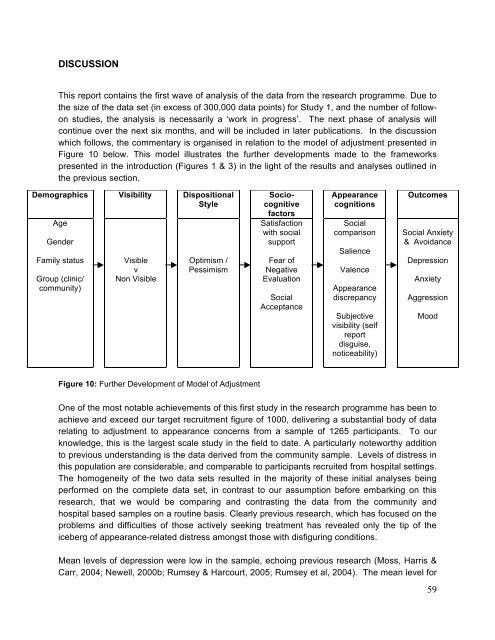Download the report - The Healing Foundation
Download the report - The Healing Foundation
Download the report - The Healing Foundation
You also want an ePaper? Increase the reach of your titles
YUMPU automatically turns print PDFs into web optimized ePapers that Google loves.
DISCUSSION<br />
This <strong>report</strong> contains <strong>the</strong> first wave of analysis of <strong>the</strong> data from <strong>the</strong> research programme. Due to<br />
<strong>the</strong> size of <strong>the</strong> data set (in excess of 300,000 data points) for Study 1, and <strong>the</strong> number of followon<br />
studies, <strong>the</strong> analysis is necessarily a ‘work in progress’. <strong>The</strong> next phase of analysis will<br />
continue over <strong>the</strong> next six months, and will be included in later publications. In <strong>the</strong> discussion<br />
which follows, <strong>the</strong> commentary is organised in relation to <strong>the</strong> model of adjustment presented in<br />
Figure 10 below. This model illustrates <strong>the</strong> fur<strong>the</strong>r developments made to <strong>the</strong> frameworks<br />
presented in <strong>the</strong> introduction (Figures 1 & 3) in <strong>the</strong> light of <strong>the</strong> results and analyses outlined in<br />
<strong>the</strong> previous section.<br />
Demographics Visibility Dispositional<br />
Style<br />
Age<br />
Gender<br />
Family status<br />
Group (clinic/<br />
community)<br />
Visible<br />
v<br />
Non Visible<br />
Optimism /<br />
Pessimism<br />
Figure 10: Fur<strong>the</strong>r Development of Model of Adjustment<br />
Sociocognitive<br />
factors<br />
Satisfaction<br />
with social<br />
support<br />
Fear of<br />
Negative<br />
Evaluation<br />
Social<br />
Acceptance<br />
Appearance<br />
cognitions<br />
Social<br />
comparison<br />
Salience<br />
Valence<br />
Appearance<br />
discrepancy<br />
Subjective<br />
visibility (self<br />
<strong>report</strong><br />
disguise,<br />
noticeability)<br />
Outcomes<br />
Social Anxiety<br />
& Avoidance<br />
Depression<br />
Anxiety<br />
Aggression<br />
Mood<br />
One of <strong>the</strong> most notable achievements of this first study in <strong>the</strong> research programme has been to<br />
achieve and exceed our target recruitment figure of 1000, delivering a substantial body of data<br />
relating to adjustment to appearance concerns from a sample of 1265 participants. To our<br />
knowledge, this is <strong>the</strong> largest scale study in <strong>the</strong> field to date. A particularly noteworthy addition<br />
to previous understanding is <strong>the</strong> data derived from <strong>the</strong> community sample. Levels of distress in<br />
this population are considerable, and comparable to participants recruited from hospital settings.<br />
<strong>The</strong> homogeneity of <strong>the</strong> two data sets resulted in <strong>the</strong> majority of <strong>the</strong>se initial analyses being<br />
performed on <strong>the</strong> complete data set, in contrast to our assumption before embarking on this<br />
research, that we would be comparing and contrasting <strong>the</strong> data from <strong>the</strong> community and<br />
hospital based samples on a routine basis. Clearly previous research, which has focused on <strong>the</strong><br />
problems and difficulties of those actively seeking treatment has revealed only <strong>the</strong> tip of <strong>the</strong><br />
iceberg of appearance-related distress amongst those with disfiguring conditions.<br />
Mean levels of depression were low in <strong>the</strong> sample, echoing previous research (Moss, Harris &<br />
Carr, 2004; Newell, 2000b; Rumsey & Harcourt, 2005; Rumsey et al, 2004). <strong>The</strong> mean level for<br />
59


